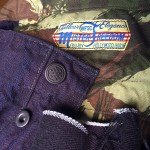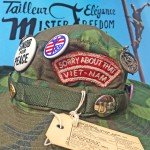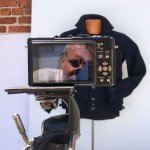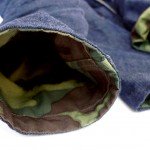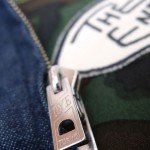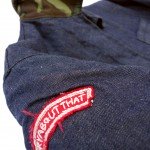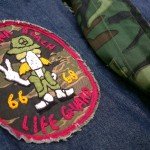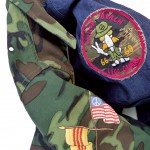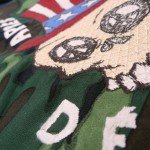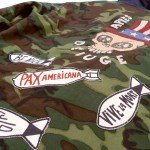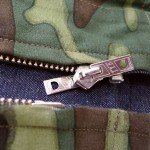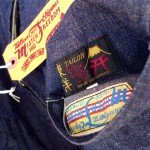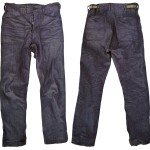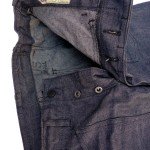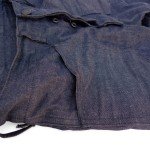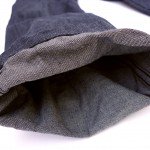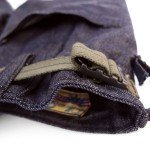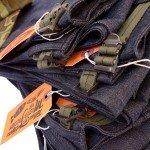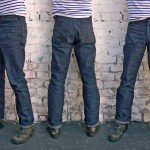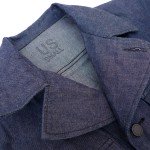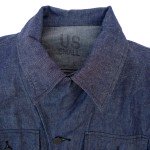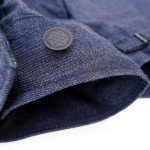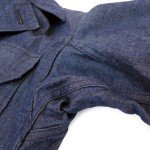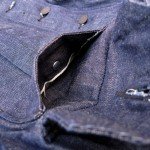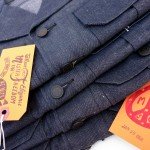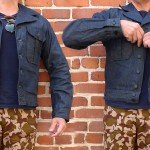 ©Mister Freedom 2015 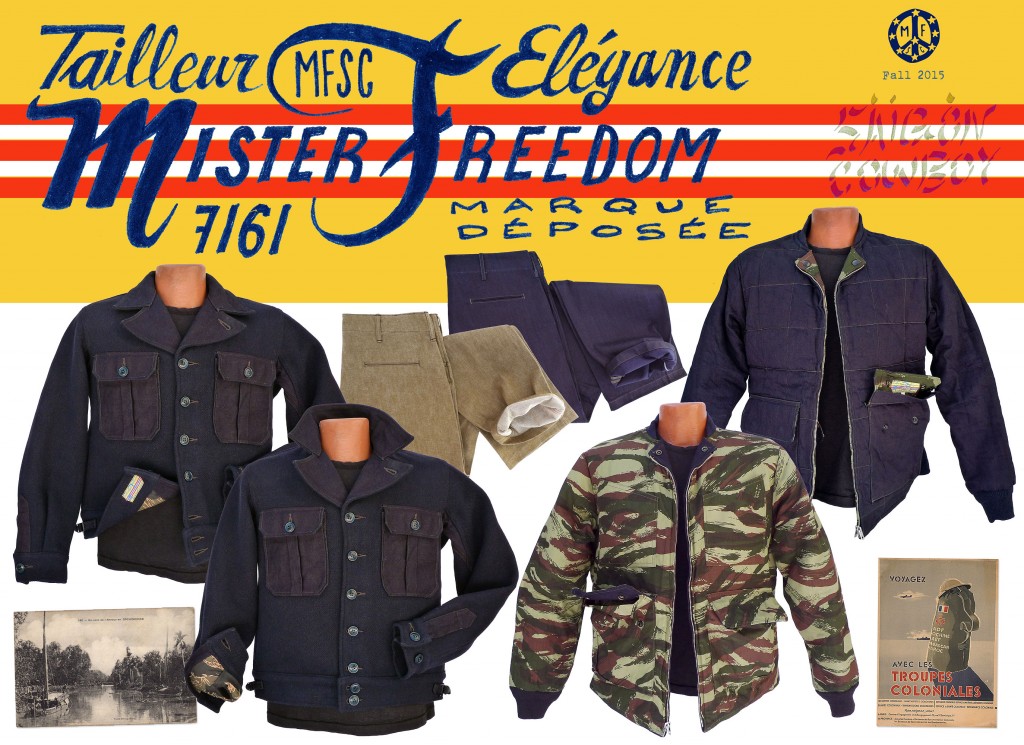 ©Mister Freedom 2015 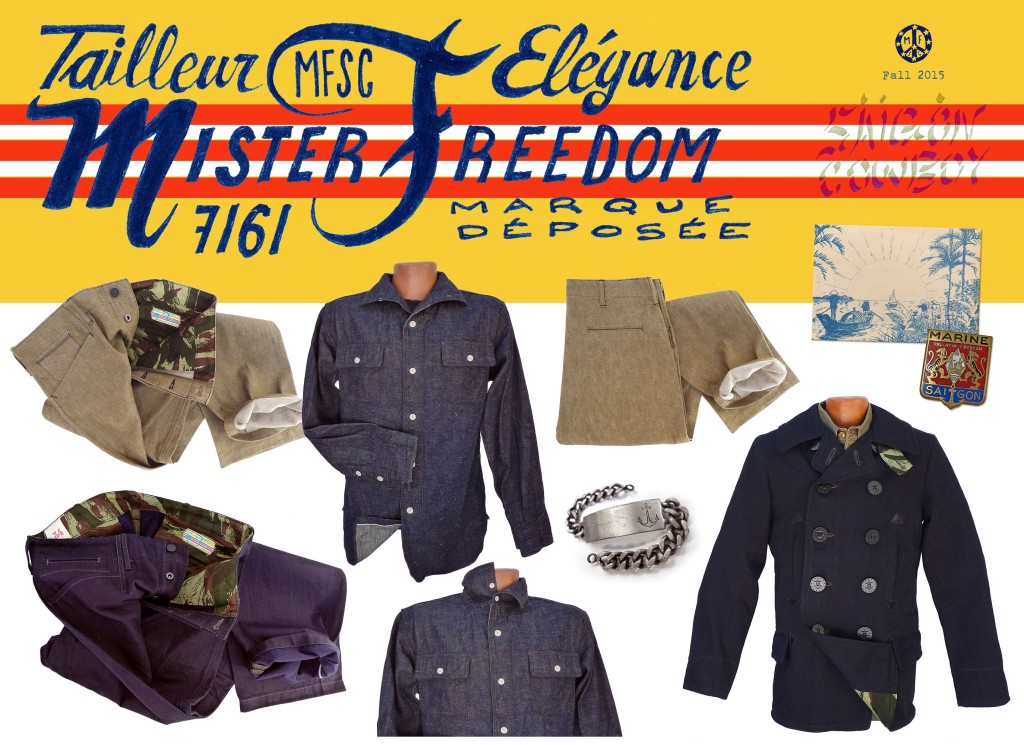 ©Mister Freedom 2015 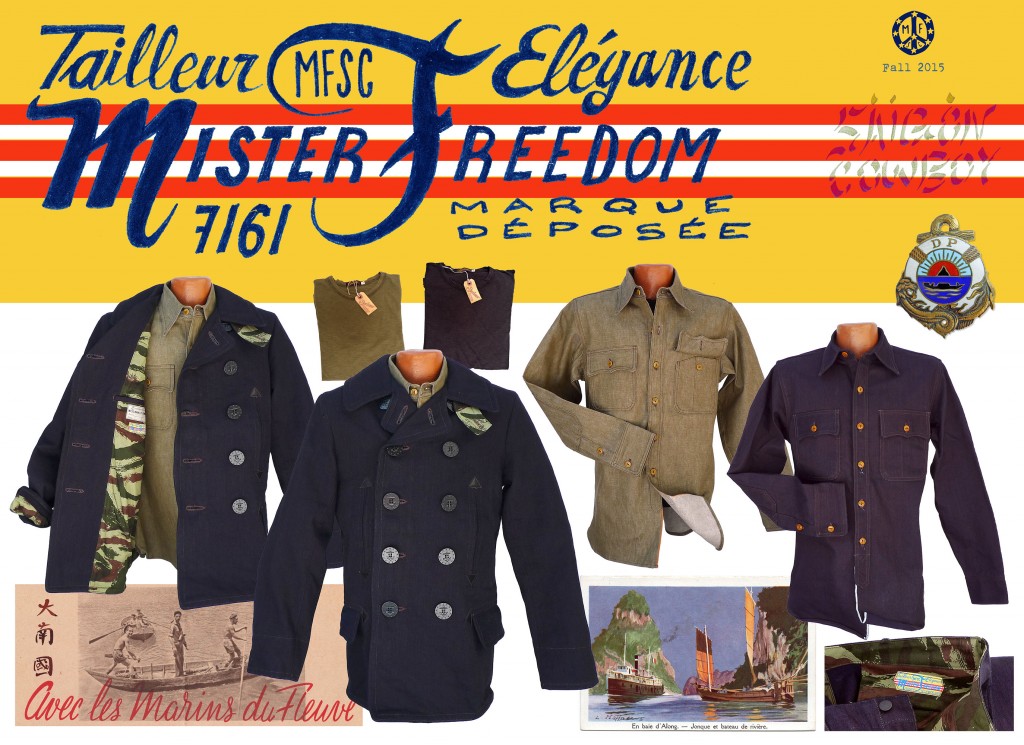 ©Mister Freedom 2015 Indochine, indigo, jungle, lézard, PBR, Brown Water Navy…
Available sometime in 2015.
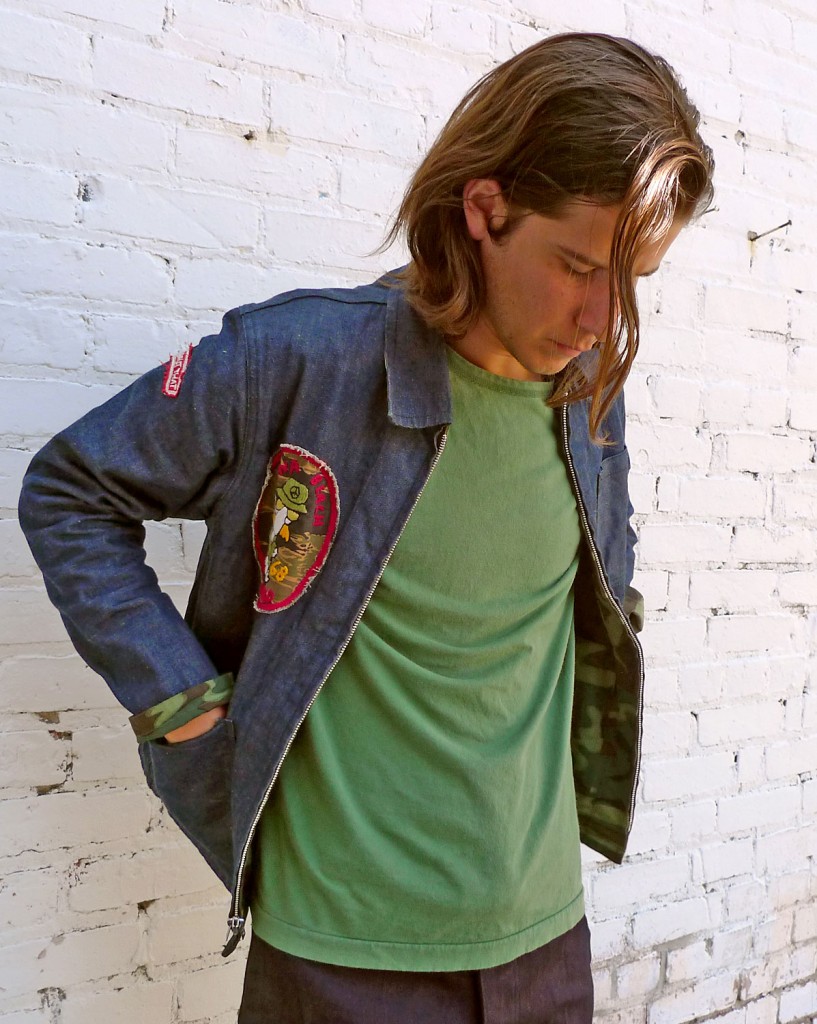
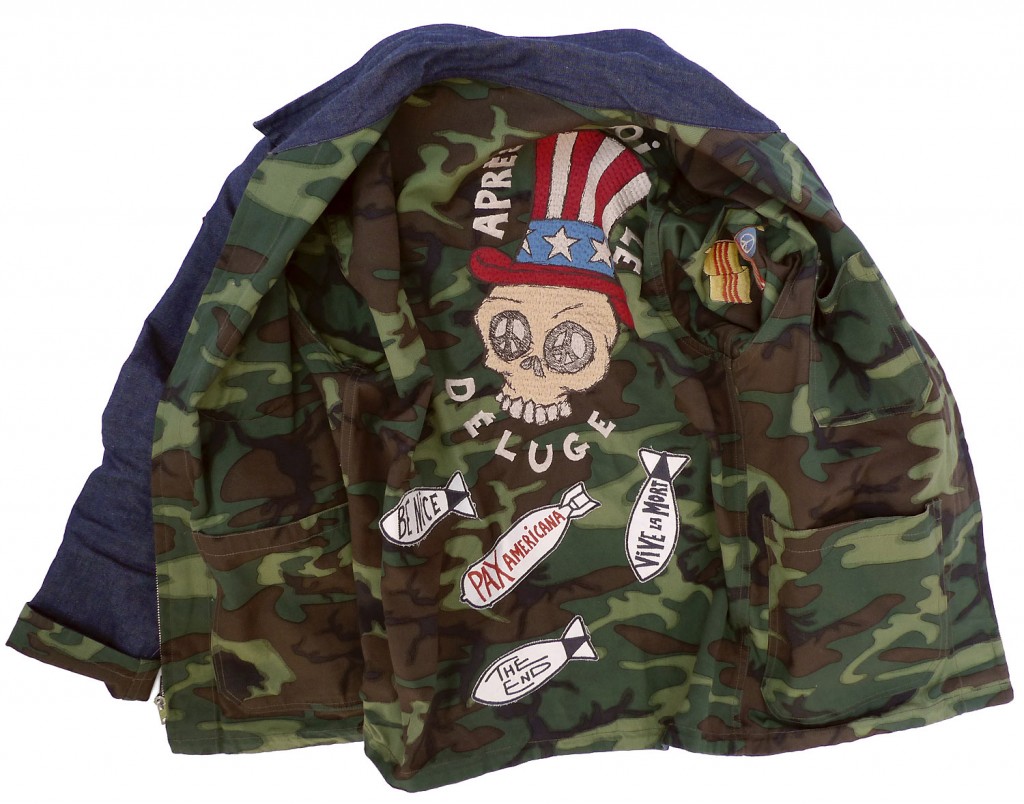
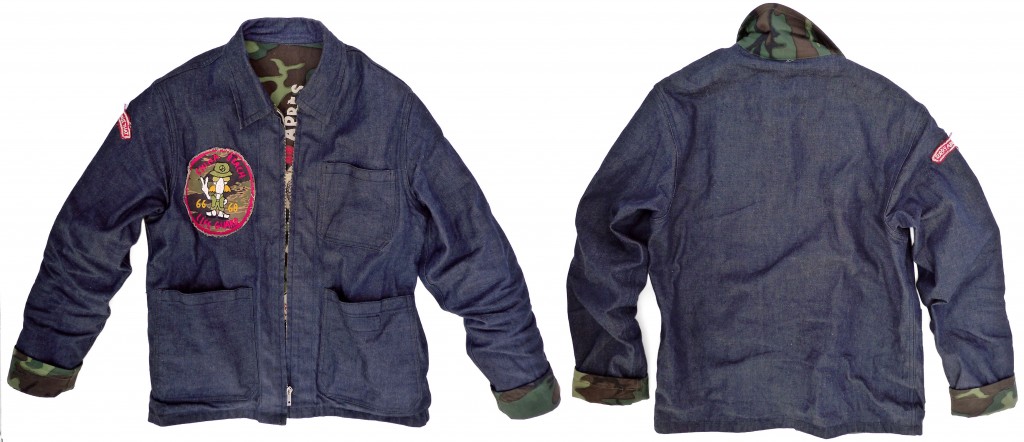
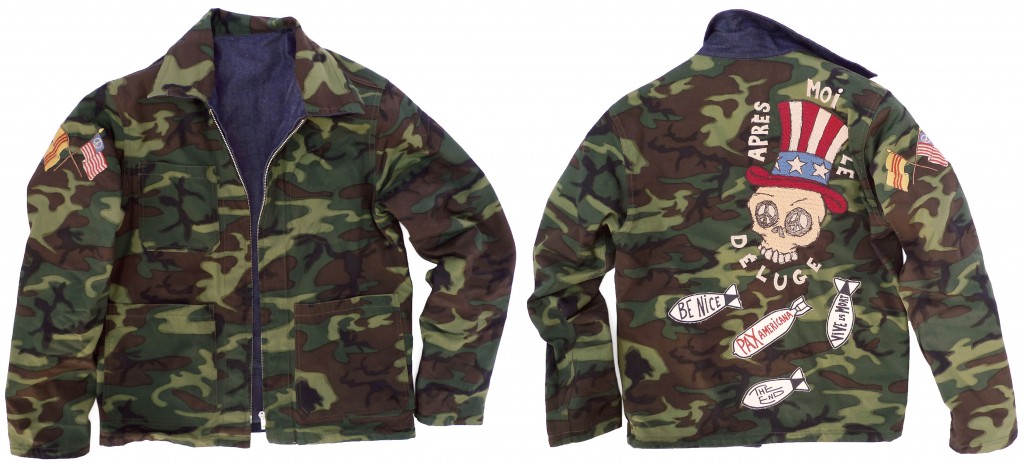
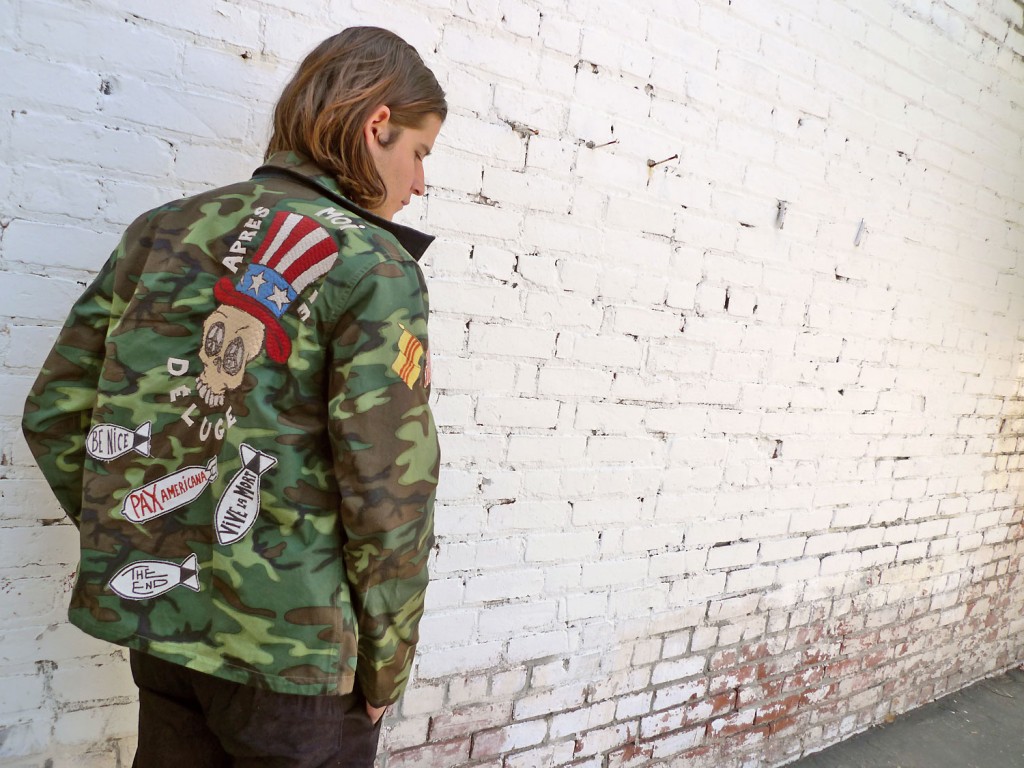
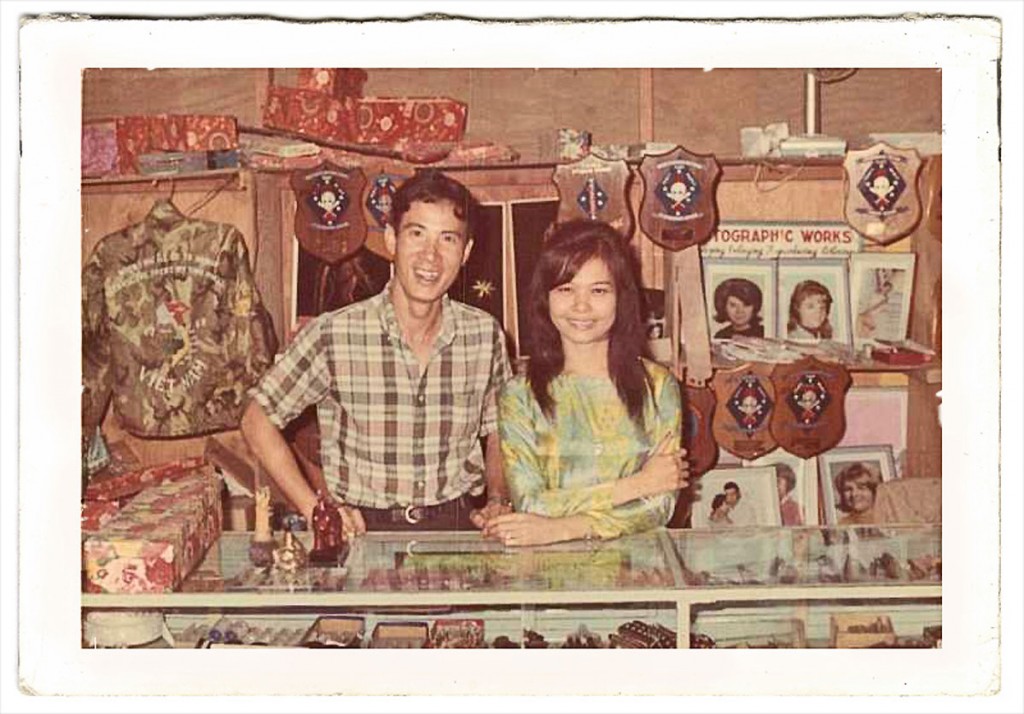 Souvenir shop at Camp Reasoner (1968) Courtesy Doc Chapman 1st Recon Bn
“Party Jacket”
Mister Freedom® x Tailor Toyo
Toyo Enterprises 50th Anniversary Limited Edition
There’s your common Fashion Industry introduction:
* Men’s cotton Jacket, embroidered, reversible. Awesome summer look! Won’t last!
* S to XL
* Import
* $ 749.95
* Buy Now.
And there’s the MF® saga version mentioning Ancient Rome, for the semiotics-inclined.
Here she goes:
It had been a very long and muggy day in that Oklahoma rag house, sorting through endless bales of used clothing as a recently-promoted vintage buyer for American Rag Cie in the early 1990’s. Back then, a few mills, who’s core business it had been for decades to recycle textiles, exporting containers of graded wearables to Africa and Asia for a few cents on the pound, and chopping the rest into wiping rags for the military or automotive industry, allowed selected pickers to come extract their ‘crème de la crème’. You would teach the grading staff in Spanish, then show up again some 3 months later to rummage through some understanding of your vintage clothing tutorial, in the form of several thousand-pound bales. It was all in the details: loop collar shirts, Hawaiian prints, side gussets, gabardine, rayon, Harris tweed, cotton madras, specific labels like Arrows or McGregor, ‘big three’ jackets (Lee Levi’s Wrangler), no acrylic or polyester, and… the mighty 501. The word selvedge had yet to become a social media hashtag, and these were times you’d rescue 1940’s beat-up Levi’s XXs from the ‘cut-to-rags’ or ‘#3 grade’ bins.
If I remember well, and I never do, the “light mix” (shirts, dresses…) was about $1.75 and the “heavy mix” (coats, #2 quality…) about $1.25 for Mid-West rag houses.
-
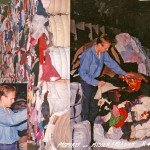
-
Rag pickin, early 1990’s
-

-
Slim pickin’ but high livin’ in Motel 6
It was around 1992. No barrel activity. Each grading section had turned silent, quite the relief after 12 hours of distorted rancheras blasting from dozens of boom boxes simultaneously playing local AM radio shows. A sign I had earned my $7.00/hour for the day at Oklahoma Waste & Wiping Rags, OKC, OK.
On the way back to my Motel 6 color TV-equipped room, I traveled in style all expenses paid, I decided to stop at a road side Salvation Army store for some LP digging before the drive-through grub. I don’t remember anything about the 50 cents record bin, but i’ll never forget pulling a pristine quilted embroidered jacket off the women’s section, with a $9.95 price tag…
‘Japan jackets’, as most called them at the time, very rarely came out of rag houses for some reason, probably ending-up on Africa-bound cargo containers, mixed in bales of Chinese embroidered silk robes and shiny nightwear… Well, I had just scored an early 1950’s New Old Stock reversible Korea tour jacket, of vibrant gold blue and burgundy silk, with flying eagles and roaring tigers… and with its original paper tag dangling from the zipper pull!
Of little impact to me at the time was the specific maker mentioned on that advertising paper flasher. Finding a garment with its original packaging was the only way to ID the manufacturer of these souvenir jackets, as they tended to never feature a sewn label. The paper ticket read “KOSHO & Co”. Sounded Japanese…
Although damaged from sun exposure and moths today, this is probably the only piece of clothing I kept from that period.
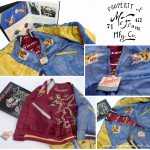 1950’s Souvenir Jacket from Kosho & Co. (book by Toyo Enterprises) Some 12 years later, around 2004, I was approached by three well-dressed Gentlemen in Los Angeles, wanting to discuss a potential collaboration between Mister Freedom® and Sugar Cane Co. They announced themselves as Mr. Tanaka, Mr Fukutomi and Mr. Onma… from TOYO Enterprises, a renowned Japanese garment manufacturer I knew from its Sugar Cane Co fame.
Established by the Father of its current President, the avid Hawaiiana and Sukajan collector Mr. Kobayashi San with whom I would later be honored to share a bi-annual handshake, TOYO Enterprises had been supplying Yokosuka PX and local shops since the mid 60’s. Everything from 501-replica blue jeans (originally featuring a gold star stitched on the rear pockets) to assorted americaji (American casual) goods, all the way to embroidered silk souvenir jackets popular with American military men stationed in Japan at the time. Serendipity has it that KOSHO & Co, an old established Japanese fabric trading company, had merged with TOYO Enterprises around 1965. Mr. Kobayashi’s team took over Kosho’s Sukajan business, and has been leading the pack since then.
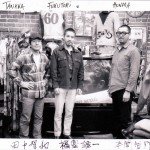 Tom, Fukutomi and Honma from Toyo Enterprises (circa 2007) Today, TOYO Enterprises is comprised of several specialized divisions, whose high standards are recognized worldwide: Sugar Cane Co, Buzz Rickson’s, Tailor Toyo, Sun Surf… 2015 marks the company’s 50th Anniversary.
For an insider’s look at Tailor Toyo’s expertise with Sukajan (スカジャン), check out this recent TV documentary (you can fast forward to 01:15), a glimpse at popular Japanese television shows targeting the young generation, English-speaker friendly. Omoshiroi! 🙂
Around the corner from Toyo Enterprises current HQ location in Ryogoku (an industrial neighborhood of North East Tokyo famous for its Sumotori schools and nightlife as exciting as a DMV appointment) stands a small shamisen shop run by an affable old Sensei I once met. In the store window are displayed official USAF aerial shots of the flattened out neighborhood, dated 1945. Recounting brutal stories about the death of thousands from US air raids during WW2, Sensei kept smiling, politely but genuinely, as if fully detached from that past. We respectfully bowed, he went back to his stringed instruments, and I went back to my fancy clothes.
If American air raids were designed to expedite the resolution of WW2 and hasten Japan’s surrender, and allegedly saved lives on both sides, these photos next to Toyo’s five-story building always remind me of the survival spirit, resilience, hard working ethics and magnanimous attitude of the Japanese… Today, the country boasts the “World’s second largest developed economy“. Not too sure what that exactly means, but it sounds pretty good. Sure is a remainder that, given the possibility, fast forwarding from bitter to better is a good idea. Some should try that in the Middle East.
Back to our jacket.
Before becoming a popular trend with Japan’s youth, from innocent fashion to ‘borderline’ xenophobic statements (see Yanki, and right-winger trucks blasting propaganda in the streets), these colorful ornate jackets were local-made souvenirs for Armed Forces personnel, a military habit probably inherited from the old naval tradition of customizing one’s gear (Liberty cuffs, painted sea bags…).
Japan, Korea, Germany, Vietnam, Philippines, Middle east, Panama… “Souvenir Jackets”, “Party Jackets”, “Cruise Jackets”, “Tour Jackets”… a little bit for everyone. Some liked the generic eagle-tiger-dragon off the rack, some custom-ordered more personal designs, some wore them while partying on liberty, some flew missions with them, some brought an irresistible kid size specimen home…
Genuine military tour jackets have played the role of flashy gang colors for bands of brothers. They have featured salty nicknames, testosterone-filled mottos, innuendos, personal creeds, specific branch pride, not-so-PC novelty patches, unit patches, dark cynical quotes in unexpected multi-colored flamboyant embroidery… Anything to cloak death under a devil-may-care veil, a requisite for men of the Armed Forces who give their life in combat so that you and I don’t have to.
Although not souvenirs but in the ‘customized military gear’ family, World War Two saw everything from sexy pin up strippers to bomb-toting Disney cartoon characters (corporately repudiated today) readily hand-painted on pilot flight jackets and fuselages. For years, authentic USAF type A-2 leather jackets featuring custom painted nose art, cockpit ‘party jackets’ if you will, have fetched top dollar. Against all odds, replicas of these have entered mainstream Japanese streetwear since the 1980’s, some jackets even featuring fictitious “Enola Gay” artwork.
-
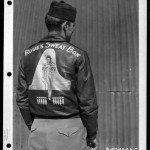
-
A-2 Jacket. “Rosie’s Sweat Box” (1945)
-
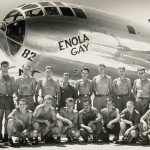
-
B-29 Enola Gay and Crew (1945)
In spite of being high-ticket collectibles as well, souvenir jackets from the Vietnam era tend to be lesser crowd-pleasers, with messages displayed usually conveying a more skeptical and cynical attitude towards the Kool-Aid, a sentiment well relayed by the many crudely engraved Zippo® lighters of the period.
The term “Party” applied to jackets/hats/suits refers to the fact that these often flamboyant garments were intended to be worn on R&R or around the mess hall rather than on operations in the boonies…
The Vietnam types were sometimes re-cut from uniforms, recycled out of quilted camo poncho liners, nylon parachutes, denim, silk kimonos… often mixing whatever fabric was available. Apart from the typical “When I die I’ll go to Heaven…” kind, party jackets of that period came in many shapes forms and colors.
Such war memorabilia is still sold to tourists in Vietnam today. The Dan Sinh Market, in Hoh Chi Minh City, is still filled with “authentic” replicas, such as gas masks, Special forces cloth patches, dog tags etc…, a man cave contributing to a small local artisan economy.
-
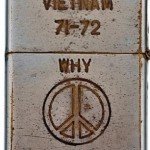
-
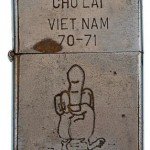
-
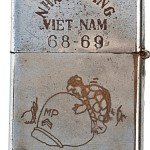
-
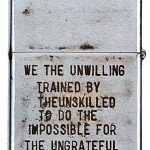
-
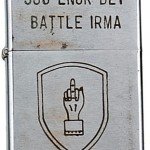
-
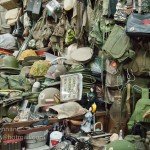
-
Danh Sinh market Photo courtesy Julian Tennant
Sometime last year, we were honored to be approached for a collaboration with the “Tailor Toyo” label on a sukajan type jacket, to mark the 2015 fiftieth Anniversary of Toyo Enterprises. Wholly immersed at the time in R&D related to the Vietnam War, it was an obvious choice for me to blend that jacket in the current Mister Freedom® “Saigon Cowboy” mfsc collection. I could have safely gone with apparently neutral eagles and tigers, but opted otherwise.
If we are usually pretty subtle with MF® garments, preferring minimal branding and ornamentation, this ‘Party Jacket’ would be different. Being reversible would help convey human duality, yin & yang, pile & face, good & evil, Jekyll & Hide, Cheech & Chong…
I do believe Man is an adorable serial-killer panda. Now that’s a good T-shirt.
Our ‘Party Jacket’ would require an individual reflection. Doing research is admittedly a challenging concept for the keyboard cowboys of the sheeple community, but like the French say, “c’est comme l’auberge Espagnole, on y trouve ce qu’on y apporte”. This idiom, originally referring to the absence of catering in old Spanish inns, roughly translates to ‘you will only find there your own contribution’, or ‘what you get out of it depends on what you put into it’.
 You talkin’ to me? And for the few not yet asleep, here are more random historical clues…
“Colonial policy is the daughter of industrial policy.”
Jules Ferry, French Prime Minister, in 1905.
It had been a national hobby in old Europe to busy fleets and commanders with royal orders to sail the four corners of the Earth in quest of both riches and heathen souls to convert. Under divine blessing, wigged men in tights invited themselves on distant shores and competed for power, empires, spices, precious metals, trade goods, raw materials and cheap labor force. Spaniards, Dutch, Portuguese, Brits and French were at it since the 16th Century. Whoever the expansionist, the bottom-line message behind the mission civilisatrice of colonialism was simple: spread the gospel but bring home the bacon. Bacon, no pun, which could prove useful back home, to reverse seven centuries of Spain and Portugal Muslim occupation. Thousands of nautical miles away, in colonized hostile jungles, while the bon sauvage strived to find salvation in his newly embraced religion, missionaries would occasionally develop a strong disposition for trading wares… All was well.
If the seafaring merchants who originally dropped anchor in Viet Nam as early as 1516 were Portuguese, the French were the ones who ultimately dropped their suitcases in the 1850’s. Followed some hundred years of tumultuous imperialist presence in Indochina, France’s only beachhead in Asia. Colons got busy milking the jungle ‘white gold’ (latex from rubber trees), while France cashed in on its Opium Monopoly scheme (the French Governor built an opium refinery in Saigon in 1899, manufacturing a fast burning mixture that guaranteed both high consumption and hefty profits). Ultimately, the imposed system stirred enough Vietnamese national pride and resistance to get France kicked out in 1954, and the US to throw the towel in 1973.
Now that I’ve lost everyone, let’s bring in the Marquise de Pompadour, royal mistress of Louis XV, and a big Elvis fan, obviously. Louis XV, renowned womanizer and ruler of the French from 1715 to 1774, made decisions some claim lead to little events erupting a few years after his passing. Although truly successful in cultural achievements in the domain of the Arts, Louis XV’s mostly unpopular reign did contribute to his successor and grandson Louis XVI’s rendezvous with Louisette (the guillotine, not the dame), on a cold winter morning of 1793, Place de la Révolution in Paris.
He also is responsible for ceding France’s territorial claims in North America to England and Spain, the reason why I have to type all this in English, and why Céline Dion’s French sounds funny.
-
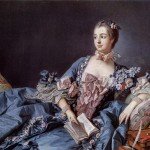
-
Marquise de Pompadour by Francois Boucher 1756
-
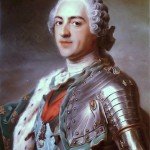
-
“Louis le bien aimé” by Maurice Quentin de La Tour
-
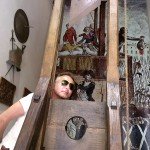
-
“Papy le bien aimé”, and Louisette
Who first pronounced the words “Après moi, le déluge“, today a quaint French expression which literally translates to ‘After me, the flood‘, is lost to History and Versailles’ corridors. It is attributed, however, to either Louis XV or La Pompadour. Its meaning is also largely open to interpretation and subtle nuances, from the irresponsible “I don’t care what happens after me” to the threatening “Watch what’s coming to you after I’m gone“. Most today use the expression with its “F*ck it” or carpe diem (seize the day) connotation, probably less relevant to the original intended meaning of egocentricity and self-importance. I personally understand it more in the 18th Century Hellfire Club motto sense: “Fais ce que tu voudras” (Do what thou wilt). But what do I know.
The pertinence of this “Après moi, le déluge” royal statement embroidered on our jacket is left to the reader’s own judgment. It could refer to some European attitudes during past colonial ventures (Patrice Lumumba would agree)… It also could refer to carpet bombing of ‘boxes’ in Vietnam-Cambodia-Laos, a scheme to demoralize the enemy, with impressive KBA (Killed By Air) scores.
“…we’re going to bomb them back into the Stone Age.”
General Curtis ‘old iron pants’ LeMay (Chief of Staff of the United States Air Force), pondering on the capability of America’s air power in 1965.
The air campaign concocted by American war strategists to bring communist North Vietnam into submission kept the USAF quite busy during the 1960’s and 70’s. The People of Vietnam, Cambodia and Laos might not relate to such bucolic names as Farm Gate, Ranch Hand, Iron Hand, Arc Light, Rolling Thunder, Barrel Roll or Linebacker… but will remember the 7,662,000 tons of bombs dropped on them during the course of the war.
Difficult to grasp such figures for us lucky enough to not even know what an enemy detonation sounds like. I heard artillery while living in N’Djamena, Tchad, in the mid 70’s. But distant and muffled, and not incoming. I didn’t live in a tunnel either.
As a reference, South East Asia got three times the ordnance tonnage used during the Second World War and its wide spread theater of operation…
During the Vietnam conflict, using everything from B-52s high-altitude raids to Skyhawk strafing attacks, the Air Force was to drop “anything that flies, on anything that moves”, dixit National Security Advisor Henry Kissinger, caught on tape relaying recent presidential instructions down the chain of command in 1969. Now if that’s not Realpolitik…
Some bomb types were given colorful nicknames by ordnance personnel, such as snake eyes, pineapples, or the charming daisy cutters. At the Air base, an explosive case could receive a custom painted graffiti before the sortie, often a considerate nod to the enemy, in popular wartime humor fashion: “Preparation H”, “It’s not the gift but the thought behind it”, “Birth Control”…
To this day, in South East Asia, unearthed aluminum ‘vintage’ bomb shells are being recycled into everything from spoons to jewelry by local rural artisans. With 25% of its 10,000 villages still plagued by UXOs (Unexploded Ordnance), Laos holds the sinister record of the “Most Bombarded Country in the World”.
No other Nation has seemed envious enough to claim that title since 1973.
-
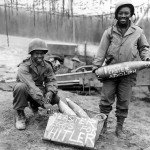
-
An old tradition
-
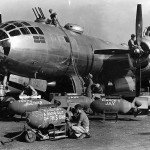
-
500th Bomb Group arming B-29 Superfortress Mariana Island (1944-45)
-
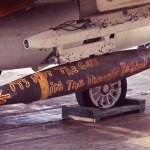
-
250 Lbs bomb on Skyhawk, Chu Lai (1965)
-
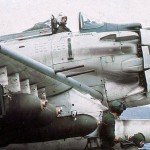
-
One toilet bomb, the six millionth pound of ordnance dropped in 1965
-
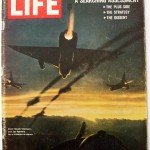
-
LIFE and death (1966)
In French, the Reaper is a Lady, she’s always on time. “Vive La Mort” (literally ‘Long live Death’) is a reference to the 1965 French movie “La 317ème Section”, directed by Indochina War veteran Pierre Schoendoerffer. During a scene in the Cambodian jungle, Sergeant Willsdorff, a seasoned man o’ war portrayed by a convincing Bruno Crémer, lets out a hearty “Vive la Mort, Bon Dieu!”, a devil-may-care attitude acknowledging we are all ultimately doomed. For Willsdorff, death is an Art de Vivre (watch here around 08:50), or as Bruce Lee put it (in his 1971 “Long Street” character), “to learn to die is to be liberated from it (…) You must learn the art of dying“.
Sometimes attributed to the French Foreign Legion, the expression “Vive la Mort” is historically more likely the battle cry of soldiers of fortunes and mercenaries.
The cinephile will also note that in Apocalypse Now (Redux), Coppola pays respect to “La 317ème Section” by quoting the egg metaphor reference of the Viet Minh demonstrating their victory over the French at Diem Bien Phu: breaking an egg in his hand, the character boasts “the white runs out, the yellow stays.”
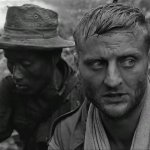 “Vive la Mort, Bon Dieu!”Bruno Cremer, 317eme Section (1965) Pax is Peace, in latin. The original “Pax Romana“ expression refers to a 200 year-long state of relative Peace achieved by prosperous Rome with its empire, some two millenniums ago.
More relevant to our jacket and applied to the United States, the formula Pax Americana relates to US foreign policy post WW2. For some, that policy carries connotations of imperialism and neocolonialism, blatant or disguised. For others, it is an ideal balanced situation, with America at its center as the World’s Peace keeper, a role only the strongest Nation on Earth can achieve, guaranteed by fire power domination. During the Vietnam conflict, the formula was put in perspective.
“Sorry About That” and “Be Nice” are references to popular quips amongst American soldiers during the Vietnam conflict. These Americanisms were also used as the tittles of two illustrated paperbacks concocted by Ken Melvin in 1966-67. Both collectible vintage pamphlets pop-up on eBay from time to time, and even pass the Amazon PC Police. Additionally, a “Sorry ’bout That” arc red patch was a common feature on customized head gear and jungle shirts during the Vietnam conflict.
Along with the Nguyen Charlie comic strips published in Stars and Stripes from 1966 to 1974, featuring VC and GI caricatures competing for survival, this literature aimed at empathizing with and entertaining US troops in the field. They are a window into America’s not-so-distant past.
The hand-embroidered patch on the ‘relatively’ discreet denim side contrasts with the cluster of the jungle-hell camo and its apparent gung-ho statement. Surfing in wartime Vietnam has been addressed in a previous post while introducing the MF® Tiger Board Shorts.
Do note that, at the time of drawing the patch, i was not aware that a “China Beach Surf Club” actually existed. Again, who needs imagination with History at hand…
There it is.
Thanks for reading.
Peace,
CL
-
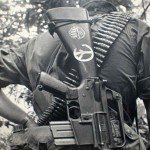
-
Peace Piece
-
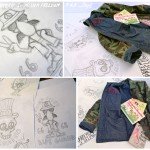
-
Doodles
-
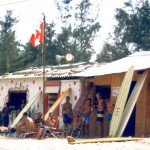
-
China Beach Surf Club, Vietnam, (1968) Photo Dennis Norton
-
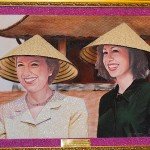
-
When in Rome… Presidential perks. Hilary & Chelsea Clinton (2000)
-
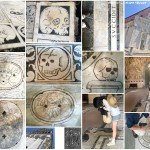
-
Morbid R&D in Tuscany, Italy. (13th-15th Century Churches)
-

-
“Do as thou wilt shall be the whole of the law”… enter at your own risk.
This “Party Jacket” matching our Saigon Cowboy Spring 2015 mfsc collection was designed in California by Mister Freedom® and crafted in Japan by Tailor Toyo and Sugar Cane Co, two branches of Toyo Enterprises, for the 50th Anniversary of the company.
SPECS:
FABRIC:
* Fully reversible garment.
Side A: 10 Oz. indigo-dyed 2×1 denim, solid white ID selvedge. Milled in Japan.
Same fabric as our Utility Trousers and Jacket.
Side B: 100% cotton ERDL ‘lowland’ camouflage printed popeline, 4.75 Oz. Milled and printed in Japan.
DETAILS
* Inspired by US military Tour/Souvenir/Party jackets.
* Fully reversible.
* All original artwork on ERDL side rear panel.
* Original hand embroidered chest patch on gold tiger stripe background.
* Expert machine embroidery using traditional Japanese kimono-making techniques.
* Three patch pockets on each side.
* Covered 1950’s sukajan style reversible “TYE Tokyo” metal zipper.
* Very Limited Toyo Enterprises 50th Anniversary Edition.
* Made in Japan.
SIZING/FIT:
The “Party Jacket” comes raw/unwashed and will shrink to tagged size.
We recommend an original cold soak, spin dry and line dry.
I usually wear a Medium (38) in mfsc jackets and am a comfortable Medium in this jacket, with room to layer.
Please refer to sizing chart for cold rinse/line dry approximate measurements.
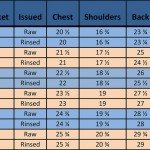
CARE:
Launder when hygiene dictates and common sense prevails.
Due to the intricate embroidery, this jacket is relatively fragile and prone to snagging. Hand wash. Fully un-zip the jacket before washing. Cold water, eco-friendly mild detergent and line dry. Fraying of the patch edges is normal and to be expected.
Patina will develop according to activities and frequency of wear.
Available RAW/unwashed
SIZES:
X-Small (34)
Small (36)
Medium (38)
Large (40)
X-Large (42)
XX-Large (44)
RETAIL $749.95
Available from www.misterfreedom.com, our Los Angeles brick & mortar store, and fine retailers around the World.
Email sales@misterfreedom.com or call 323-653-2014 with any questions unanswered above.
Thank you for your support.
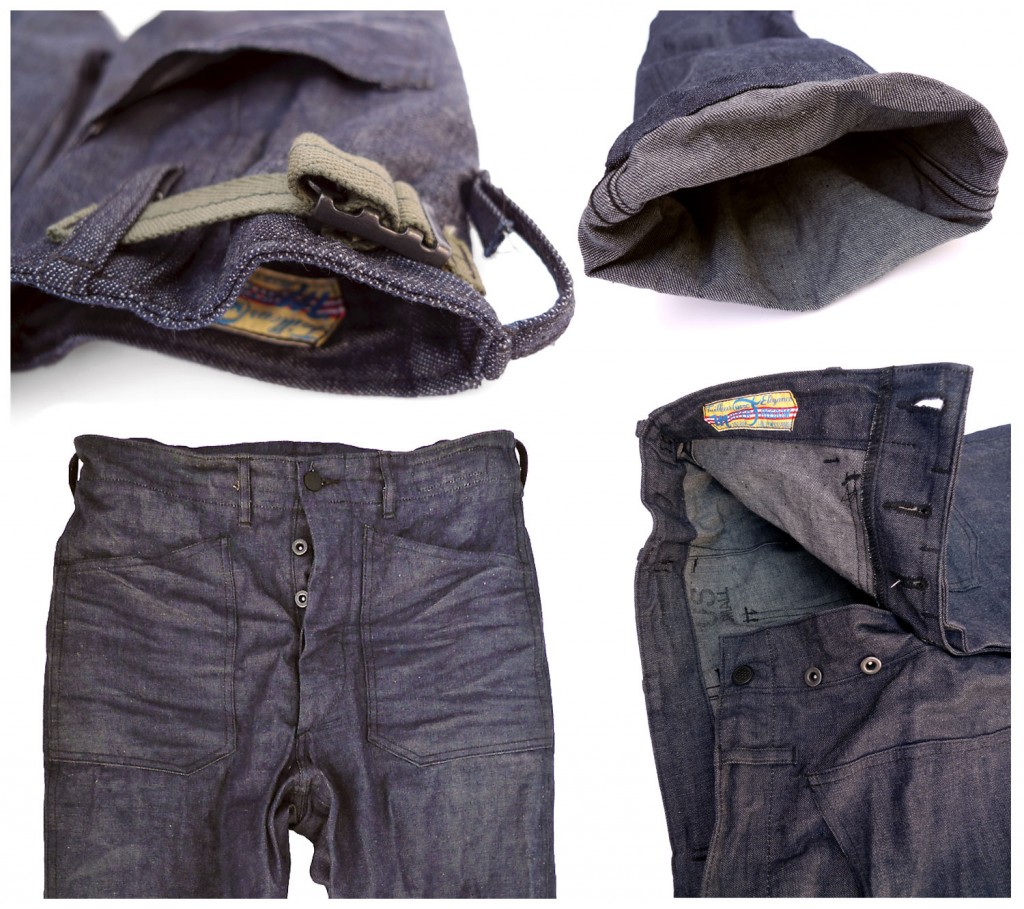
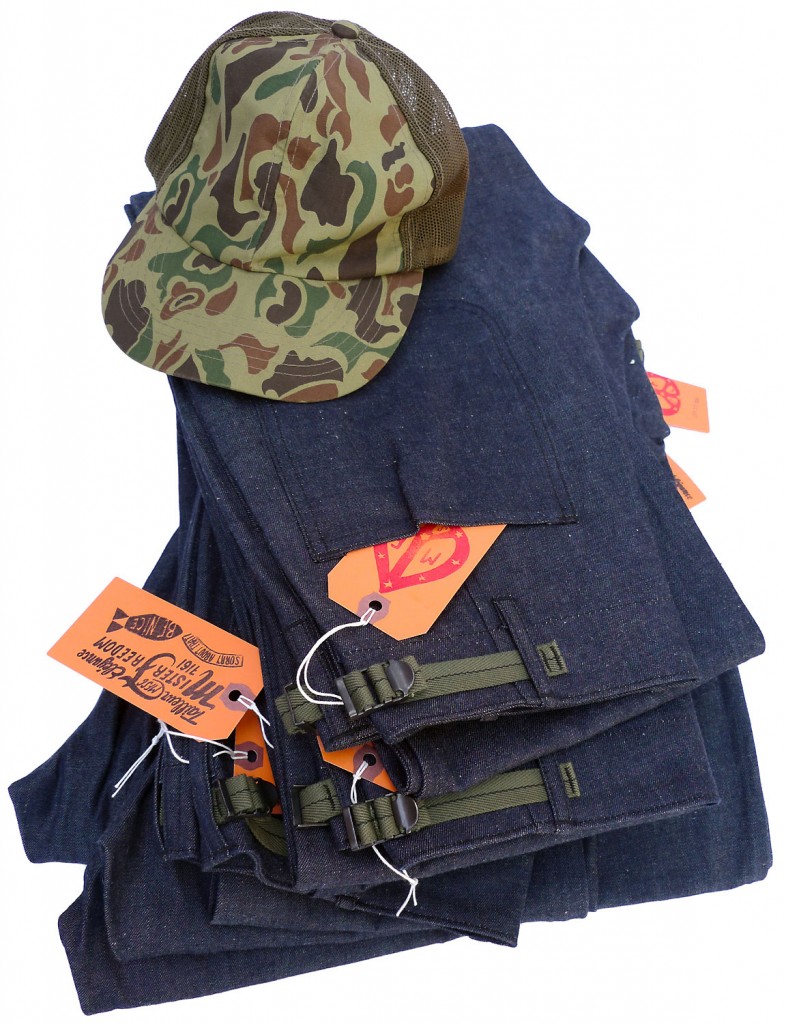 Redneck hat optional
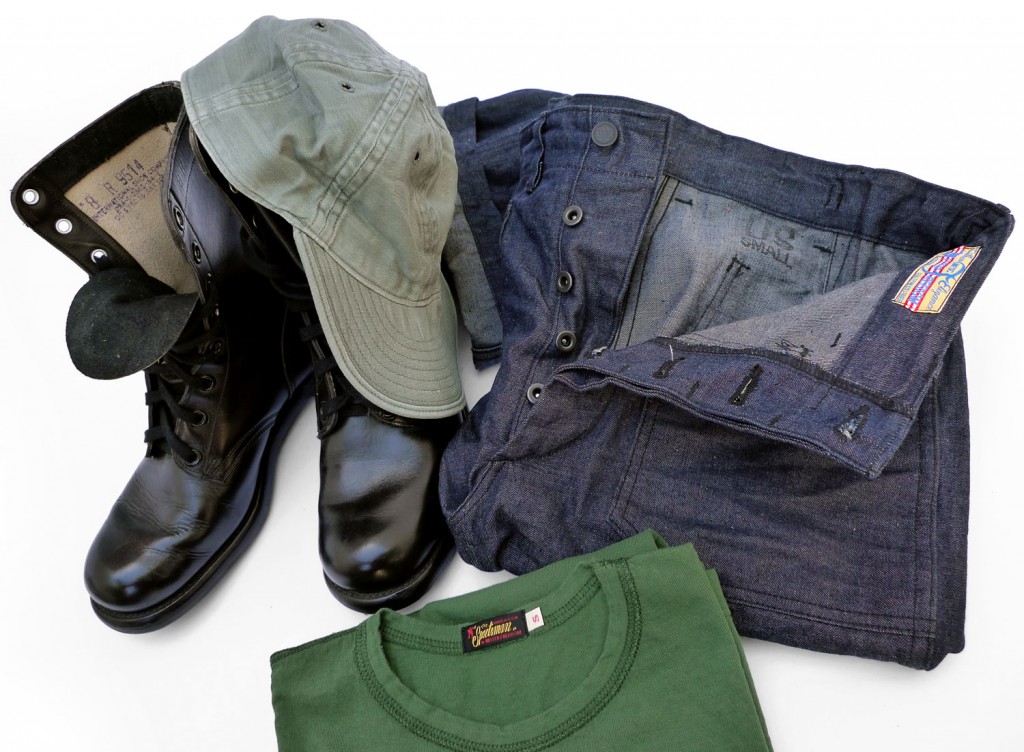
Utility Trousers, Denim
“Saigon Cowboy” mfsc spring 2015
utility
u·til·i·ty
yo͞oˈtilədē/
adjective
* functional rather than attractive.
Example: “utility clothing”
There is it.
We previously introduced the featured trousers of our Saigon Cowboy spring collection with their recent experimental camo release. The same pattern was used for this denim issue. The Utility Trousers, Denim borrow details from US Navy dungarees (CONTRACT DA-30-352TAP-2031 to be precise), Army chino trousers, M-51 field trousers, Marine Corps M1941 trousers… all blended in the MF® shaker.
The fabric is that of the Utility Jacket, Denim, inspired by the lightweight 2×1 denim of original 40’s-50’s US Army barrack bags.
Expertly milled in Japan based on a vintage US Army un-issued barrack bag from 1951, our new 10 Oz. indigo-dyed selvedge denim features a slight nep (woven ‘imperfections’ in the form of tiny whitish cotton balls), with the stiff-dry-crispy feel of NOS denim.
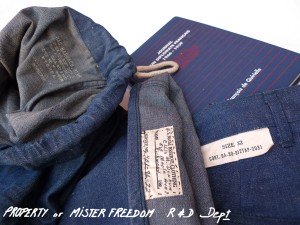 Blue inspiration As a work-type garment not having to rank high in attractiveness, our Utility Trousers are quite inconspicuous, in and out. And, do mark your calendars, we went as far as not show the selvedge anywhere. Refreshing, isn’t it. For the selvedge galore, and a tantalizing KP duty tuxedo, check out the trousers’ matching top.
To complete the unassuming appearance, our utes feature black-painted ‘burst of Glory’ type metal buttons, black oxidized donut fly buttons, and black color cotton thread tonal stitching.
The specific sizing S,M,L,XL applied to trousers could sound odd, but is a nod to old military field pants featuring cinch tabs. Those are often tagged with a ‘size range’ as opposed to a precise measurement, reflecting the waist-adjusting pull tabs.
The “US” stamp stands for sizing following American standards, as opposed to the “A” stamp differentiating Asian standards garments with CISO-issued gear.
Along with our Evac Jak and Utility Jacket, Denim these Utility Trousers, Denim are extrapolations of historical events we are briefly evoking as we unfold this Saigon Cowboy collection. Some will be familiar with these pages of History, some will wonder why on Earth we’re turning them, some will enjoy learning tidbits, some will want to burn the book, some will zip to the washing instructions…
I personally consider the Past to be valuable forewarning material, rather than mere dust for under the rug. You don’t agree or not with factual History, you are either aware of it and learning a lesson, or ignoring it and perpetrating more of the same. Most readers of this blog are probably too young to have either fought or protested the Vietnam war. Still, mentioning it in 2015 seems important food for thought to me. I won’t be sharing macabre combat photography that no one wants to look at, nor glamorize events either. I won’t even tell it like it is, because I was 10 when it ended and have no idea how it was. But enticing one to look things up with these brief posts will hopefully prove more useful than sharing self-coaching quotes on cutesy sunset photo backgrounds, or other such inspirational platitudes social media grace us with. History comes in handy in the voting booth.
“How are you tomorrow?”
Michael Herr, Dispatches (1977)
The Utility Trousers, Denim are designed in California by Mister Freedom® and manufactured in Japan by Sugar Cane Co.
FABRIC:
10 Oz. indigo-dyed 2×1 denim, solid white ID selvedge. Milled in Japan.
DETAILS:
* Inspired by vintage military utility trousers.
* Mid-high waisted.
* Front patch pockets locked in side seam, rear patch pockets, horizontal HBT.
* Side cinch tabs, mil-spec slide buckle.
* Flat black-painted Metal “13 Stars” tack waist button.
* Oxidized black donut-type fly buttons.
* Flat felled seams, chainstitch.
* 100% cotton tonal stitching.
* Made in Japan.
SIZING/FIT
This garment comes raw/unwashed and will shrink to tagged size after an original cold soak/line dry. Further shrinkage to be expected with the use of hot water and heat dryer.
I decided to size down in those, as I had done with the Crew Pants of the Sea Hunt spring 2013 collection, and I am wearing a Small (30). When both fully cinched, the waist tabs can tighten the fit by about 2 inches, but a Medium looked too baggy on me. A tagged Small technically corresponds to a 30-32 inch waist.
Please refer to sizing chart for measurements reflecting a 30mn cold soak no agitation/line dry.

CARE:
Launder when hygiene dictates and common sense prevails.
Machine wash. Cold water, gentle cycle, eco-friendly mild detergent and line dry. We recommend turning indigo blue/denim garments inside out to avoid marbling when washing.
Patina will develop according to activities and frequency of wear.
Available RAW/unwashed
SIZES:
X-Small (28)
Small (30)
Medium (32)
Large (34)
X-Large (36)
XX-Large (38)
RETAIL $329.95
Available from www.misterfreedom.com, fine retailers around the World, and our dusty Los Angeles brick & mortar store.
Email sales@misterfreedom.com or call 323-653-2014 with any questions unanswered above.
Thank you for reading and for your support
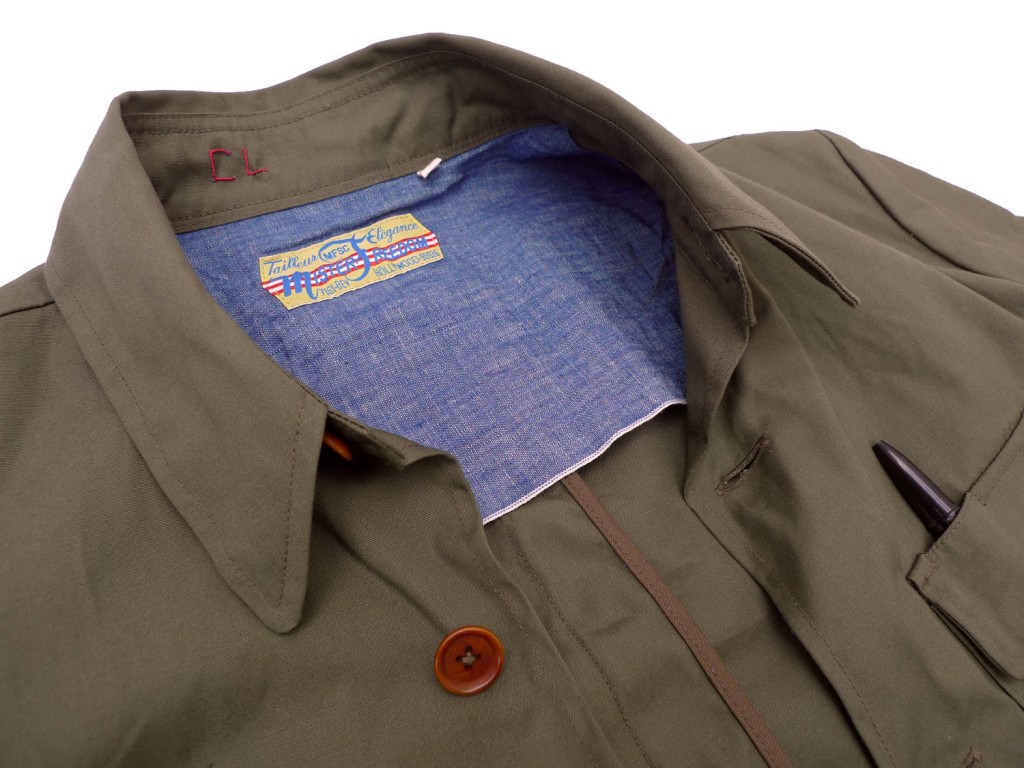 The Continental: “Bush” Model 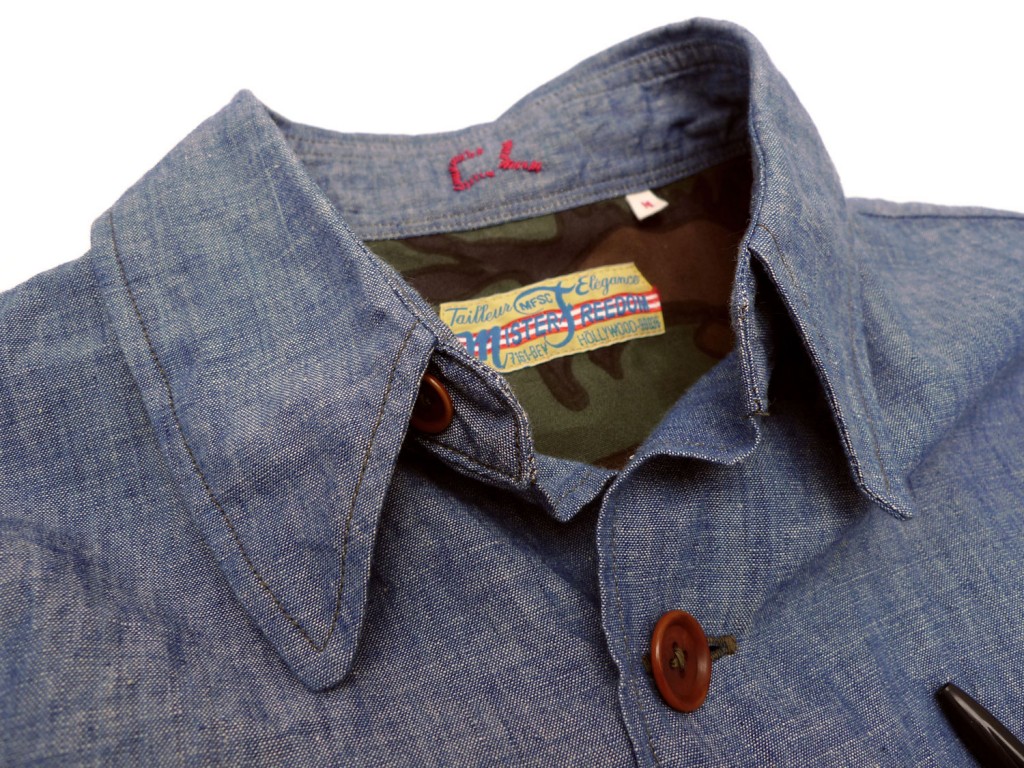 The Continental: “Cholon” Model 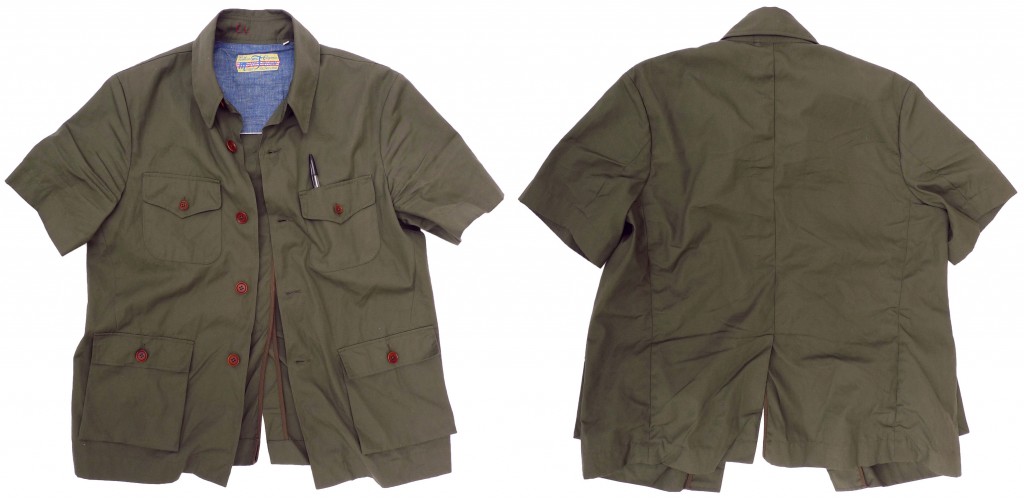 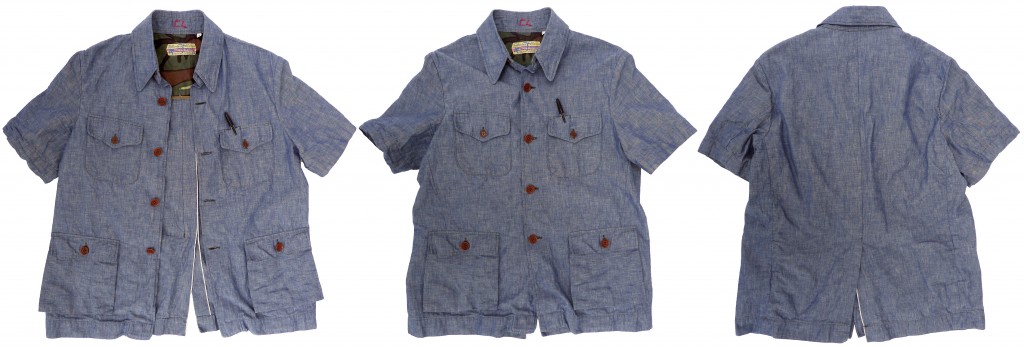
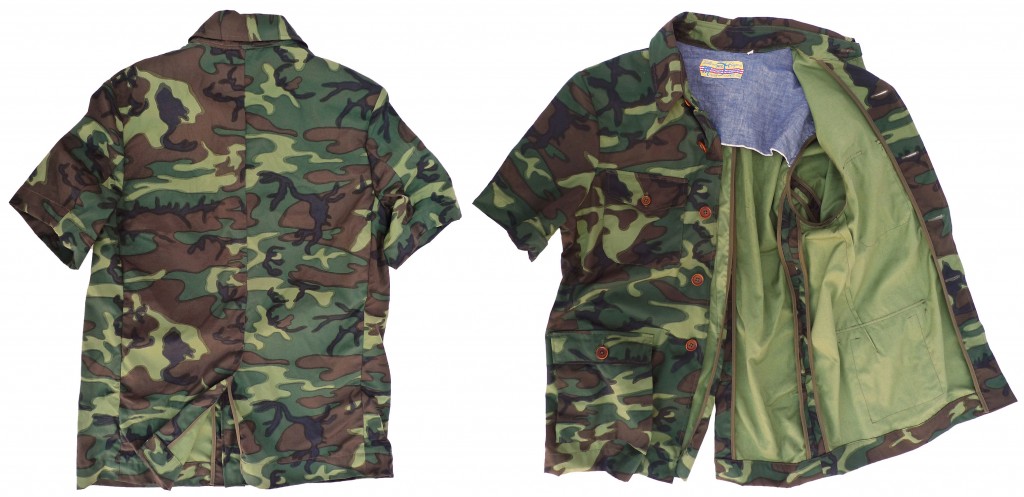
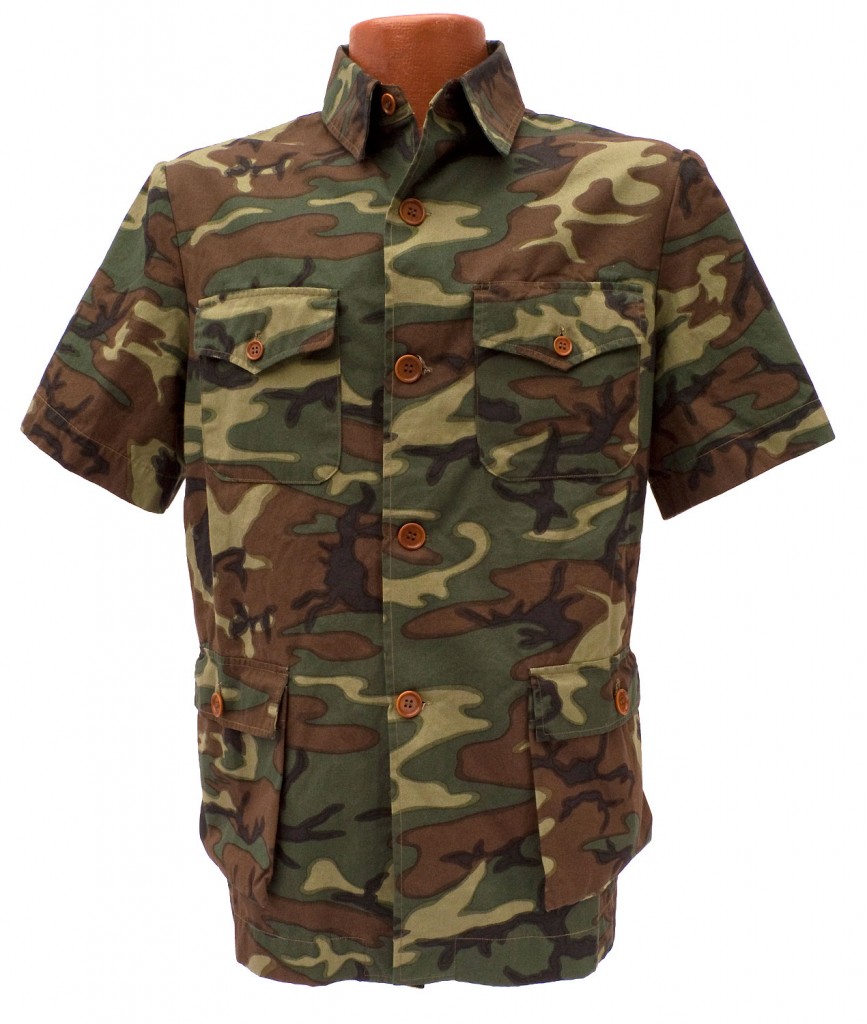 The Continental: “Cowboy” Model
-
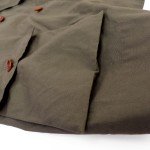
-
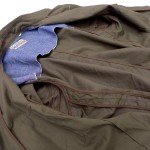
-
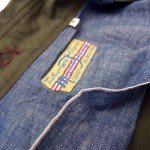
-
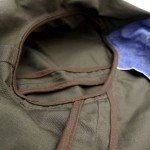
-
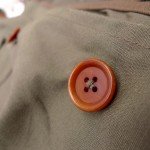
-
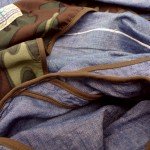
-
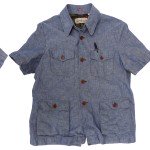
-
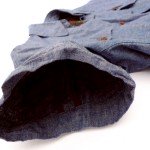
-
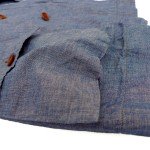
-
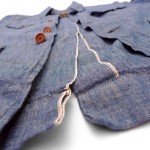
-
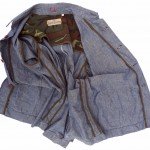
-
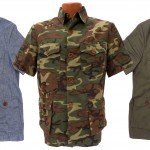
-
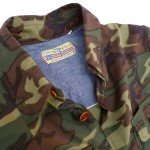
-
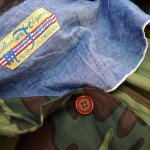
-
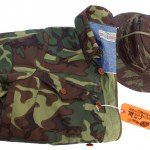
-

-
Venice cowboy
-

-
It can be argued that 3/4 sleeve + 1/4 sleeve = 1 long sleeve
The ‘Continental’
Mister Freedom® “Saigon Cowboy” mfsc Spring 2015
Cho Lon, a long time ago…
Piasters changing hands Rue des Marins, Triad run parlors, the infamous Bay Vien, ‘Maitre de Cholon‘ and the feared Bình Xuyên gangs, White Mice patrols, the yellow walls of the World’s largest gambling hall rivaling in decibel with Macao’s roaring finest, hazy opium dens, snake wine and fine Cognac, white nón lá and garrison caps, local taxi girls and international high society, áo dài and white linen suits, stalled Citroën 2CV and frantic cyclo-pousses, Bastos cigarettes smoke-filled cabarets… while thousands of sampans rest on the Arroyo.
And a stone’s throw to the East, the ‘Pearl of the Orient’: Saigon.
-
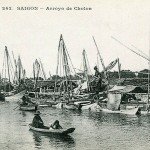
-
The Arroyo, Cholon
-
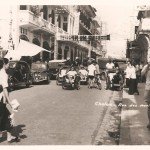
-
Cholon Rue des Marins (1930?)
-
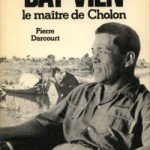
-
Bay Vien Le maitre de Cholon (Pierre Darcourt 1977)
-
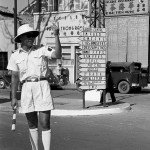
-
The Saigon police, aka ‘White Mice’ in Cholon (1950) LIFE
-
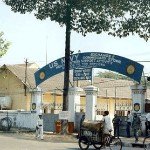
-
USN PX Cholon (1966) Courtesy Dan Byrd
It is not out of nostalgia for its colonized past, with men in white pith helmets or OD M1, that Ho Chi Minh City is still referred to as Sài Gòn by some Vietnamese nationals today. This serves as a subtle reminder of the violent troubled past of that South East Asia corner of the World, hinting at the controversial topic of the reunification of Vietnam achieved by the communist-lead North in 1975. For locals, choosing the name Saigon over its official HCM City version is not pure semantics, but a political statement that conveys a lingering identity crisis.
It is the stuff of wars to leave everything in grey areas. Nothing ever stays black or white for long. Lines had plenty time to get blurry during the 30 year-long civil war that opposed North and South Vietnam, a territorial split originally prescribed by an international band of concerned experts arguing at a Geneva round table in 1954…
I recently had a conversation with a person of Vietnamese background, born in North Vietnam in the 1960’s and of Chinese parents. You’d figure that would put you on the celebrating side after the war was won… Turns out her family joined the ranks of the three million refugees who were to flee the Indochinese peninsula in the years following the victory of communist North Vietnam, China and Russia’s protégé.
The troops of General Võ Nguyên Giáp, the Northern national hero and victor of the French Army in 1954, would claim Saigon in April 1975. Everyone who had sided with or fought for South Vietnam feared the purge. The Saigon government, backed by of a long-disillusioned America, had been the wrong horse to bet on. Hanoi was the new sheriff in town, the cadres his deputies.
As Saigon was falling, one could witness surreal scenes of men stripping down to their skivvies, watching triumphant soviet-built T-54 NVA tanks roll into town. Some roads leading to the capital were littered with abandoned ARVN uniforms…
Vietnam’s American war was officially over. But not everyone’s woes.
” Yes we defeated the United States. But now we are plagued by problems. We do not have enough to eat. We are a poor, underdeveloped nation. Vous savez, waging a war is simple, but running a country is very difficult.”
Phạm Văn Đồng (Prime minister of North Vietnam from 1955 to 1976) reflecting in 1981.
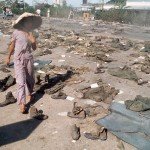 Abandonned ARVN uniforms, fall of Saigon (April 30 1975) Photo Jacques Pavlovsky Sygma CORBIS But let’s rewind a bit and take a stroll down Đồng Khởi, better known to some as Freedom Street.
The bustling downtown artery of the South Vietnam capital had been named Rue Catinat up until the end of the French occupation in 1954. It would be renamed Tu Do Street for the next twenty years. Tự Do means freedom in Vietnamese…
In its early days, Tu Do Street was lined by colonial architecture buildings housing offices, institutions, hotels, cafés, and an array of small boutiques and family-owned businesses. At number 132-134 stood Vietnam’s first hotel, the “Hotel Continental”, a Saigonese landmark since 1880, built ten years before a certain Nguyễn Tất Thành (aka Uncle Ho) was born. Owned by an allege member of the Corsican Mafia for years, the Continental had welcomed guests from all walks of life. Its clientele had been a lively mix of French rubber industry magnates aka ‘Michelin men‘, spooks, opium addicts, celebrities, quiet Americans, diplomats, thrill seekers, Air America crews, visiting mistresses, writers, stringers, tipsters, gangsters, opera singers, war groupies, plain tourists… Some guests were at times a combination of a few of the above. Current affairs were constantly being discussed and gossiped about at the Continental’s terrace (aptly nicknamed “Radio Catinat” by some), and the international press found enough material there to feed flows of dispatches heading to a fascinated foreign audience.
-
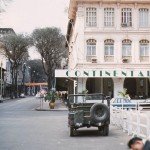
-
The Continental Palace Saigon (1968)
-
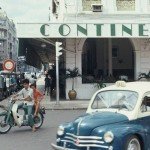
-
Continental Hotel 1971 John Binfield
-
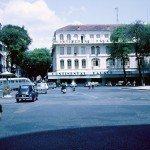
-
Continental Palace, Saigon (1963)
-

In the 1960’s, as Westmoreland demanded more and more troops be sent ‘in-country’, most of them 19 year-old GIs, demand for local ‘entertainment’ grew. The Tu Do Street eclectic mix of establishments inevitably turned into Sleazesville. Still, next to its air-conditioned cabarets, Saigon tea dives and massage parlors, one could find yard goods boutiques and honest tailor shops. Skilled Vietnamese and Chinese thread and needle specialists mixed traditional and European influences in custom creations, targeting both a civilian and military personnel clientele unaccustomed to affordable bespoke fashion.
“... he was dressed in one of those jungle-hell leisure suits that the tailors on Tu Do were getting rich cranking out, with enough flaps and slots and cargo pockets to carry supplies for a squad…“
(Excerpt from the ever relevant ‘Dispatches’ by Michael Herr, 1977)
-
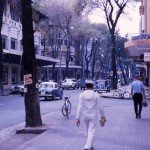
-
Tu Do Street (1964)
-
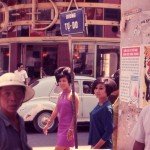
-
Tu Do Street (circa 1966) Courtesy Rachel Smith
-
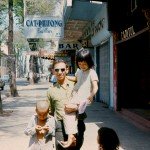
-
Tu Do Street Cat Phuong Tailleur (1967) Phillip Hakes
-
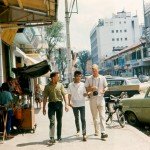
-
Saigon (1967) Photo Phillip Hakes
-
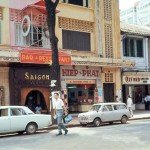
-
Tu Do Street (1967), notice the “La PAIX” tailor in the right corner, which is replaced by a girlie bar in the 1971 photo of the same block
-
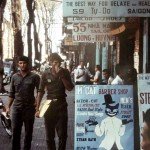
-
Tu Do Street Saigon (1968) LIFE
-
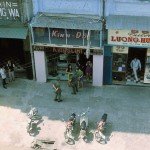
-
Tu Do Street (1970-71) Courtesy Steve (MACV Advisory Team 280)
(Vintage photo credits: Visual time travel courtesy of the internet, photos sourced here, there and everywhere. Gratitude to the owners of those flikr accounts for making their photostreams publicly available, for the sake of History preservation. Full credit to those who originally snapped the shots and chose to share them. I try to give credit to the best of my knowledge. Viewer discretion advised on some albums, war is hell.)
<><><><><><><><><><><>
And now, at last, a few words about our “Saigon Cowboy” garment du jour.
The Mister Freedom® ‘Continental‘ shirt/jacket only features four pockets and might not qualify as jungle-hell-ready, but a glance at its intricate inside construction makes it look quasi tailor-made. For the detail-oriented who opens a garment to check its structure, the combination of bias tape piping and fabric selvedge is quite pleasant to the eye, if we may say so ourselves. Our Continental might have had its place in a Tu Do Street store front window display.
Style-wise this jacket is a combination of several influences: fancy 1950’s-70’s unlined tropical gear, short sleeve blazers popular with the African elite, safari-type pocketing, elegant uniform silhouette, whiffs of colonial empires, Old World tailoring, Larry Burrows‘ wardrobe… and the mighty Sun Zhongshan suit, a favorite in China since 1949.
Our ‘Continental‘ overall pattern is adapted from a vintage late 60’s custom-made jacket, the work of a Vietnamese tailor by the name of My Nha, located at 827 D. Nguyen-Tran (unidentified city).
-
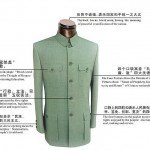
-
The Sun Zhongshan suit
-

-
Say the ‘what’ suit, son?
-
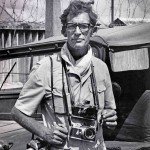
-
Larry Burrows (1965)
-
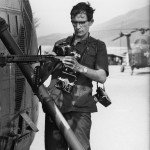
-
Larry Burrows (1966) Time & LIFE Pictures/Getty Images
-
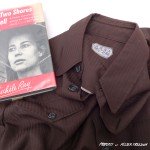
-
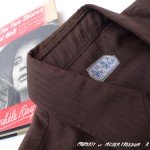
As much as I liked that vintage jacket, I figured we all could live without the 100% polyester fabric of the original sample. We opted instead for the following three textile options:
a) The “Bush” model (not to be misunderestimated): 100% cotton mil-spec OD popeline shell / 100% cotton Buzz Rickson’s USN selvedge blue chambray lining yoke.
b) The “Cholon” model (for the man of leisure): 100% cotton BR’s USN selvedge blue chambray shell / 100% cotton ERDL camo popeline lining yoke.
c) The “Cowboy” model (special jungle-hell edition): 100% cotton ERDL camouflage popeline / 100% cotton BR’s USN selvedge blue chambray lining yoke.
For those into Making Ofs, some boring bits behind the MF® Saigon Cowboy woven rayon label this season:
Our ‘local tailor’ looking MF® label combines the yellow background with three red stripes of the flag of South Vietnam and, for a USO flavor, the red white and blue of Old Glory. The specific rectangular shape with beveled corners seems typical of Vietnamese custom tailor woven labels of the period that I have seen.
-
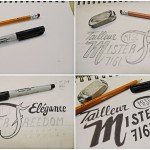
-
Making of the Spring 2015 label
-
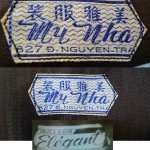
-
Vintage woven labels
-
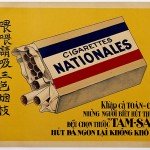
-
Cigarettes Nationales poster (1930)
-
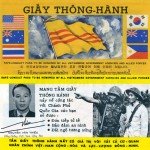
-
Vietnamese Safe Conduct Pass
-
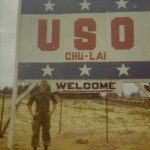
-
USO Chu Lai, courtesy Donald P. Sloat
-
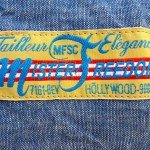
-
Voila!
-
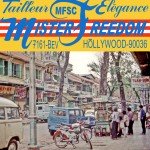
The “Continental” is designed in California by Mister Freedom® and manufactured in Japan by Sugar Cane Co.
SPECS
FABRICS
Three options, fabrics milled in Japan:
a) The “Bush” model: 100% cotton mil-spec OD popeline shell / 100% cotton Buzz Rickson’s USN blue chambray lining yoke.
b) The “Cholon” model: 100% cotton BR’s USN blue chambray shell / 100% cotton ERDL camo popeline lining yoke.
c) The “Cowboy” model: 100% cotton ERDL camo popeline / 100% cotton BR’s USN blue chambray lining yoke.
DETAILS
* Pattern inspired by tropical tailor-made attire, with a sober ‘Mao suit’ influence.
* Yes, we dared make a short sleeve blazer.
* Elegant tailored uniform-like silhouette with elaborate darting.
* Two chest flap pockets, one pencil slot.
* Two lower flap cargo pockets, ‘invisible’ stitch.
* All inside seams finished with OD color bias tape, unless selvedged.
* Corozzo wood buttons, golden brown.
* Two-piece back with vent.
* Made in Japan
SIZING/FIT:
Our ‘Continental’ comes raw/un-rinsed and will shrink to tagged size after a rinse/dry process. All three options will approximately shrink to the same measurements.
We recommend an initial cold soak, spin dry and line dry. The wrinkling ensuing this process is normal, in line with the ‘tropical’ look effect.
If you are a Medium in mfsc shirts/jackets, you are a Medium in the ‘Continental‘. Because of the specific cut, the darting and requirements of this blazer-like pattern, this shirt/jacket will not fit every frame. For instance, the arm construction, although comfortable, disqualifies this jacket as beach-volley attire. There are no expansion pleats.
Please consider the measurements below for an idea of the proportions and resulting fit.
CARE:
Launder when hygiene dictates and common sense prevails.
Hand wash or delicate cycle machine wash. Cold water, eco-friendly mild detergent and line dry.
Patina will develop according to activities and frequency of wear.
Available RAW/unwashed
SIZES:
Small
Medium
Large
X-Large
XX-Large
RETAIL $329.95
Available from www.misterfreedom.com, our Los Angeles brick & mortar store, and fine retailers around the World.
Email sales@misterfreedom.com or call 323-653-2014 with any questions unanswered above.
Thank you for your support
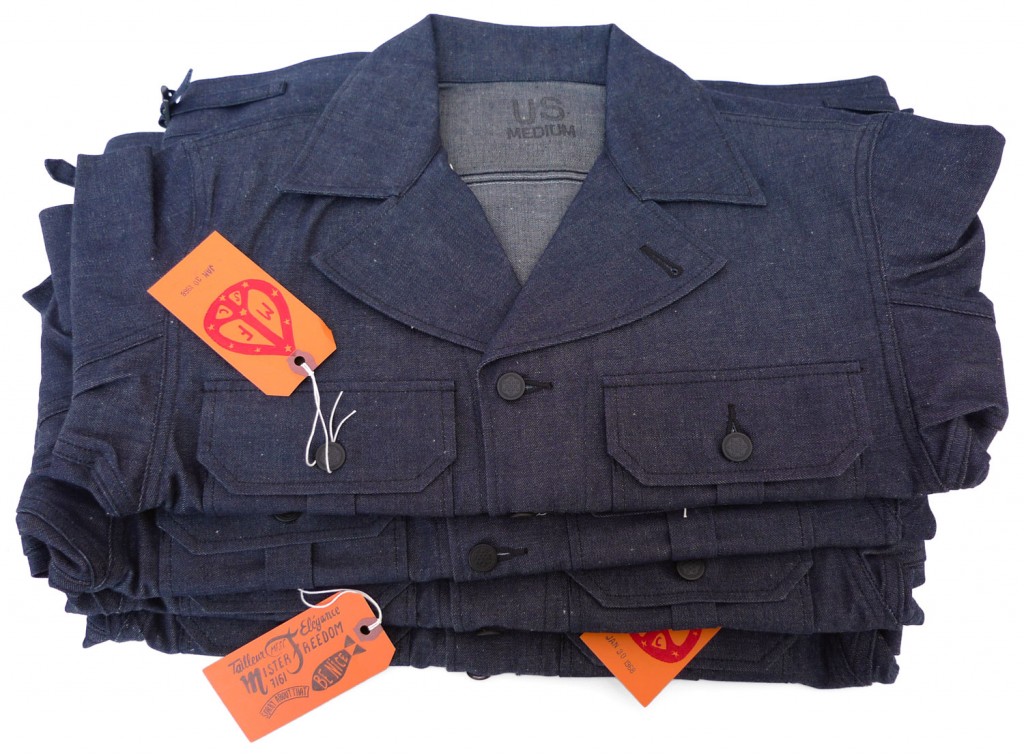

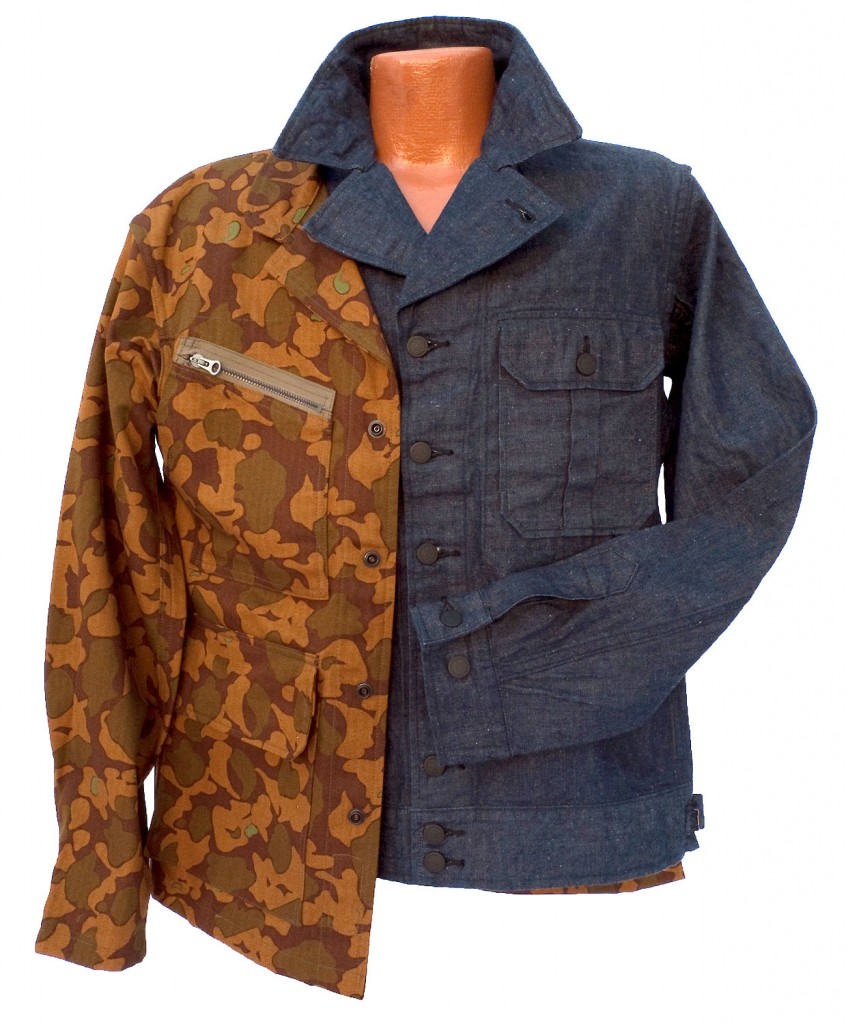
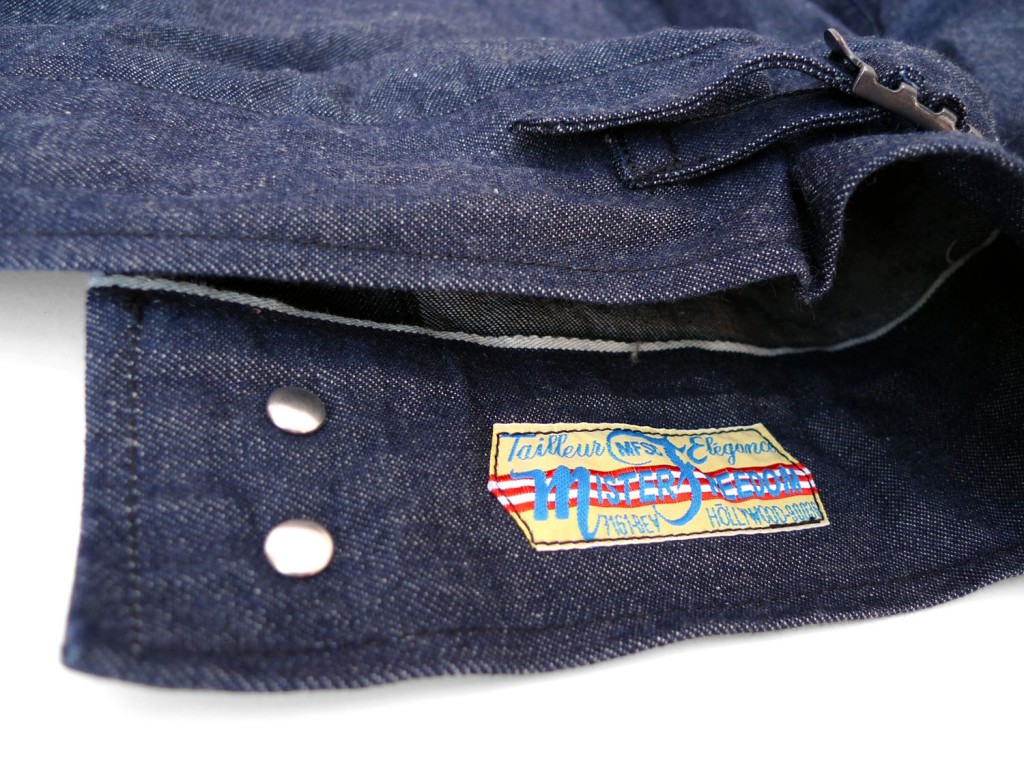
Utility Jacket, Denim.
“Saigon Cowboy” mfsc Spring 2015
I must fully credit the US Army for the design on this number. The overall pattern of the MF® ‘Utility Jacket, Denim‘ is lifted from a first issue HBT M1941 utility jacket. In 1941, this olive drab HBT short work jacket had replaced the blue denim work uniform. It appears the R&D labs had picked up a bit of influence from civvy work clothes with this specific GI garment, very much resembling a pair of mechanic coveralls chopped in half.
We pretty much stuck to the original pattern, but what we didn’t lift is the awkward oversized original army fit. Some of you who have tried on vintage ones will relate. The HBT M1941 jacket was to be worn as an outer protective layer while on chore duty, rendering it about as flattering as a pair of coveralls. Unless you’re Veronica Lake.
Speaking of curves, some of my favorite features on this jacket are the attractive lapel line curve, and the armpit gusset construction. I don’t often take photo of my armpits, but next time I do, I’m wearing this jacket.
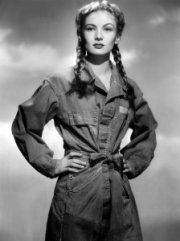 Veronica Lake in M1938 coveralls (1943) There is a well-documented mention in the “United States Marine Corps. Uniforms, Insignia and Personal Items of World War II” book (ISBN:0-7643-2264-8) of a custom theater-made USMC jacket based on that M1941 pattern, cut from a recycled frogskin shelter half:
” …some enterprising Seabee might have set up shop and sold/traded such camo sets to anyone who so wanted one, that is, as long as materials lasted!”
Such historical anecdotes (or plausible story in this case) tend to spark all kinds of ideas when designing clothes, which beats staring at what the other guys are doing for “inspiration“.
Now the fabric… If the Army went from blue denim to OD HBT as the cloth of choice for their utilities sometime in the late 1930’s, we figured we’d go back to denim for our jacket. I always had a thing for the lightweight 2×1 denim of the 40’s-50’s US Army barrack bags. Who doesn’t like those old stenciled WW2 beat up ones. Some 10 years ago, I was lucky to come across a stack of about 80, gathering dust in an old military surplus storage, outside Paris, France. Talk about custom markings inspiration.
Through our Sugar Cane Co friends, we managed to have some selvedge denim woven to the specs of an original un-issued bag part of that loot that we had kept in the archives. The Japanese mills did a great job. Spot on NOS military denim color face and reverse, slight nep (woven ‘imperfections’ in the form of tiny whitish cotton balls), stiff, dry and crispy. Perfect for our lightweight jacket.
-
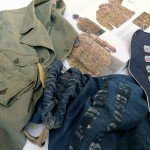
-
Well-worn vintage HBT M1941 MF® Archives ©2023
-
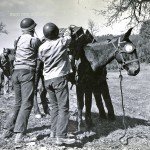
-
GI Mule Skinners (1944) Courtesy Sam Cox
-
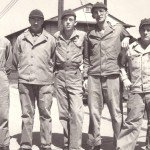
-
Eclectic US Army field jacket line-up (1943) (M1941 on right)
For the geographic requirement of our “Saigon Cowboy” collection, we took Mr. Glenn‘s Seabee bit from the Canal to the ‘Nam.
We had mentioned CISO declassified true story in a previous post, its logistics role in the Vietnam war and how custom gear was manufactured on Okinawa in the 1960’s to outfit US personnel en route to Vietnamese jungles or other across the fence places…
Our experimental camouflage Utility Trousers, the Evac Jak, and now the ‘Utility Jacket, Denim‘ are extrapolations of these pages of History, stretched out at will à la MF®. Nothing literal, just plausible fiction.
As a ‘work’ garment, our jacket looks quite subtle from the outside. We opted for black-painted ‘burst of Glory’ type metal buttons, black color cotton thread tonal stitching, and a skillfully orchestrated selvedge galore on the inside… That’s if you can take your eyes off the attractive armpits.
The “Utility Jacket, Denim” is (re)designed in California by Mister Freedom® and manufactured in Japan by Sugar Cane Co.
SPECS
FABRIC:
10 Oz. indigo-dyed 2×1 denim, solid white ID selvedge. Milled in Japan.
DETAILS:
* Revisited pattern of the US Army M1941 Utility jacket.
* Waist length.
* Side cinch straps, mil-specs metal sliders.
* Selvedge waistband, chest pocket fold and inner pocket.
* ‘Bat sleeve’ pattern with gusset for arm hole comfort.
* Expanding box pleat chest pockets.
* Inner chest pocket.
* ‘Burst of Glory’ type metal buttons, painted black.
* Adjustable cuffs.
* Chainstitch construction, black 100% cotton thread.
* mfsc ‘tailleur‘ woven label on the inside waistband.
* Made in Japan.
SIZING/FIT:
Our “Utility Jacket, Denim” comes raw/un-rinsed and will shrink to tagged size after a rinse/dry process.
We recommend an initial cold soak, spin dry and line dry.
I had to SIZE DOWN on this one, and opted for a SMALL, preferring the fit on me over a MEDIUM that looked too big.
Please refer to sizing chart for measurements reflecting a 30mn cold soak, no agitation, light machine dry.
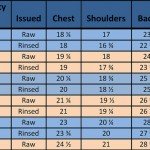
CARE:
Launder when hygiene dictates and common sense prevails.
Machine wash. Cold water, gentle cycle, eco-friendly mild detergent and line dry. We recommend turning indigo blue/denim garments inside out to avoid marbling when washing.
Patina will develop according to activities and frequency of wear.
Available RAW/unwashed
SIZES:
Small
Medium
Large
X-Large
XX-Large
RETAIL $369.95
Available from www.misterfreedom.com, our Los Angeles brick & mortar store, and fine retailers around the World.
Email sales@misterfreedom.com or call 323-653-2014 with any questions unanswered above, such as where does Sam Cox find all this stuff?
Thank you for your support 🙂
|




